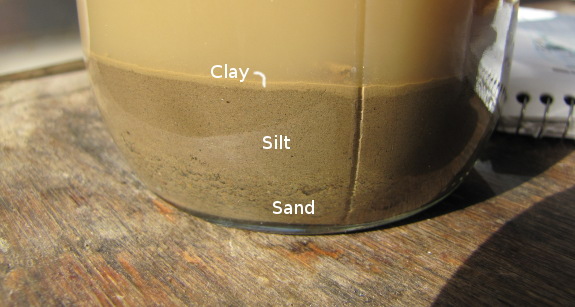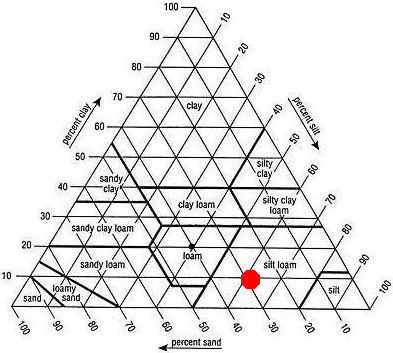
Jar test to measure soil texture

Do you want to learn
about your soil without paying a lab? Jar tests are a quick
and fun way to
figure out the texture of your soil. Simply put some
of your garden soil in a Mason jar, add a bunch of water, shake it up,
and let the soil settle into layers. Sand will drop to the
bottom, followed by silt, then (eventually) clay.
In the photo at the top
of this post, my soil has been settling for about a day,
but there's still a lot of clay in suspension (dirty-looking
water.) I wanted to post about it now, but I'll take a second
round of measurements later once the water is entirely clear.
 Using the data so far, I can
figure out the percentage of each type of soil particle by measuring
how high the layer is and dividing by the height of all the soil in the
jar. My soil is 29% sand, 64% silt, and 7% clay.
Using the data so far, I can
figure out the percentage of each type of soil particle by measuring
how high the layer is and dividing by the height of all the soil in the
jar. My soil is 29% sand, 64% silt, and 7% clay.
Next I use a soil
texture triangle to figure out what type of soil I have. I start
at 29% sand on the bottom of the triangle, then follow that line up and
to the left at an angle until I reach the line for 64% silt and 7%
clay. I put a red dot at the result --- a silt loam.
You can get this same
information by looking at the soil survey for your area. I have
an ancient paper copy, but you can get the
same information online nowadays. The front
garden area where I took the sample for my jar test is listed as a
Teas-Litz silt loam --- looks like I did it right!
Here's what the soil
survey says about Teas-Litz silt loam:
I'm actually pretty glad that I didn't pore over the soil survey while buying land because the USDA's analysis is wrong for no-till, homestead-style management. This soil is my front garden, which I consider high quality, and it produces great vegetables. Of course, that's because I hold all of my topsoil in place with mulch, rarely churn up the soil, and add lots of organic matter. The power of permaculture!
Our chicken waterer never spills or fills with
POOP.
Want more in-depth information? Browse through our books.
Or explore more posts by date or by subject.
About us: Anna Hess and Mark Hamilton spent over a decade living self-sufficiently in the mountains of Virginia before moving north to start over from scratch in the foothills of Ohio. They've experimented with permaculture, no-till gardening, trailersteading, home-based microbusinesses and much more, writing about their adventures in both blogs and books.
Want to be notified when new comments are posted on this page? Click on the RSS button after you add a comment to subscribe to the comment feed, or simply check the box beside "email replies to me" while writing your comment.

Can you please tell me how I can get permission to use your jar/soil test photo in a book? Thanks! Janet